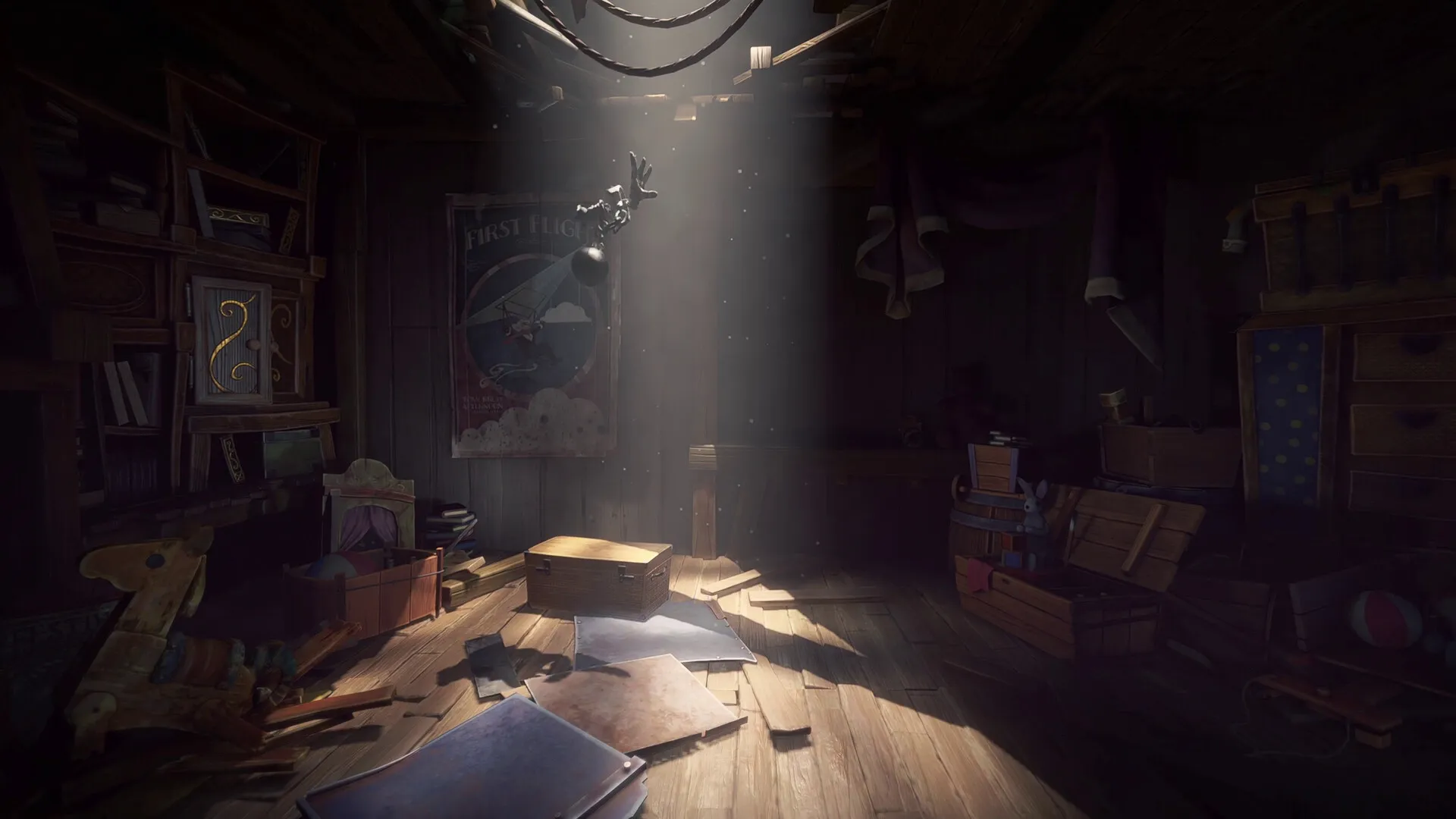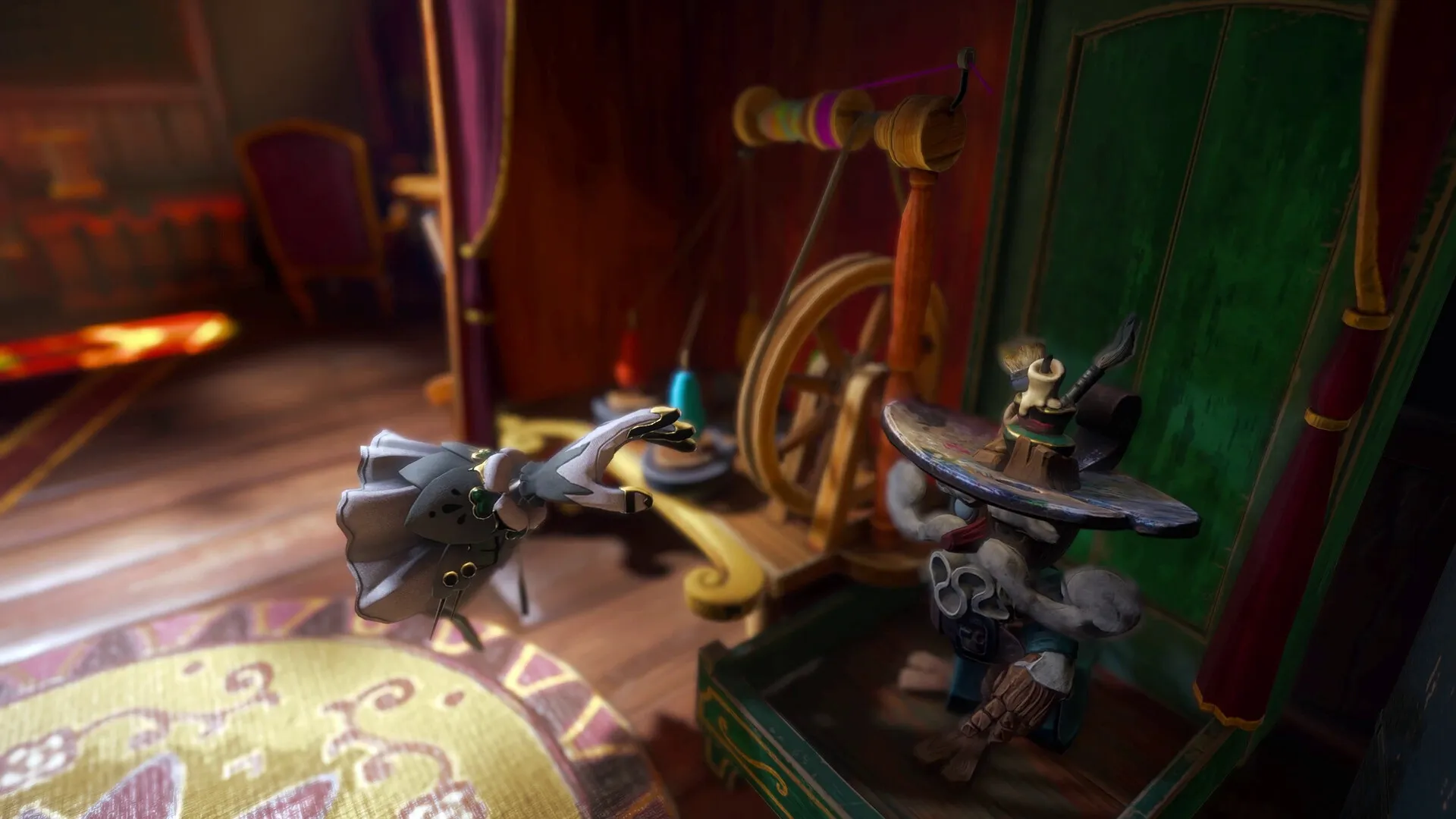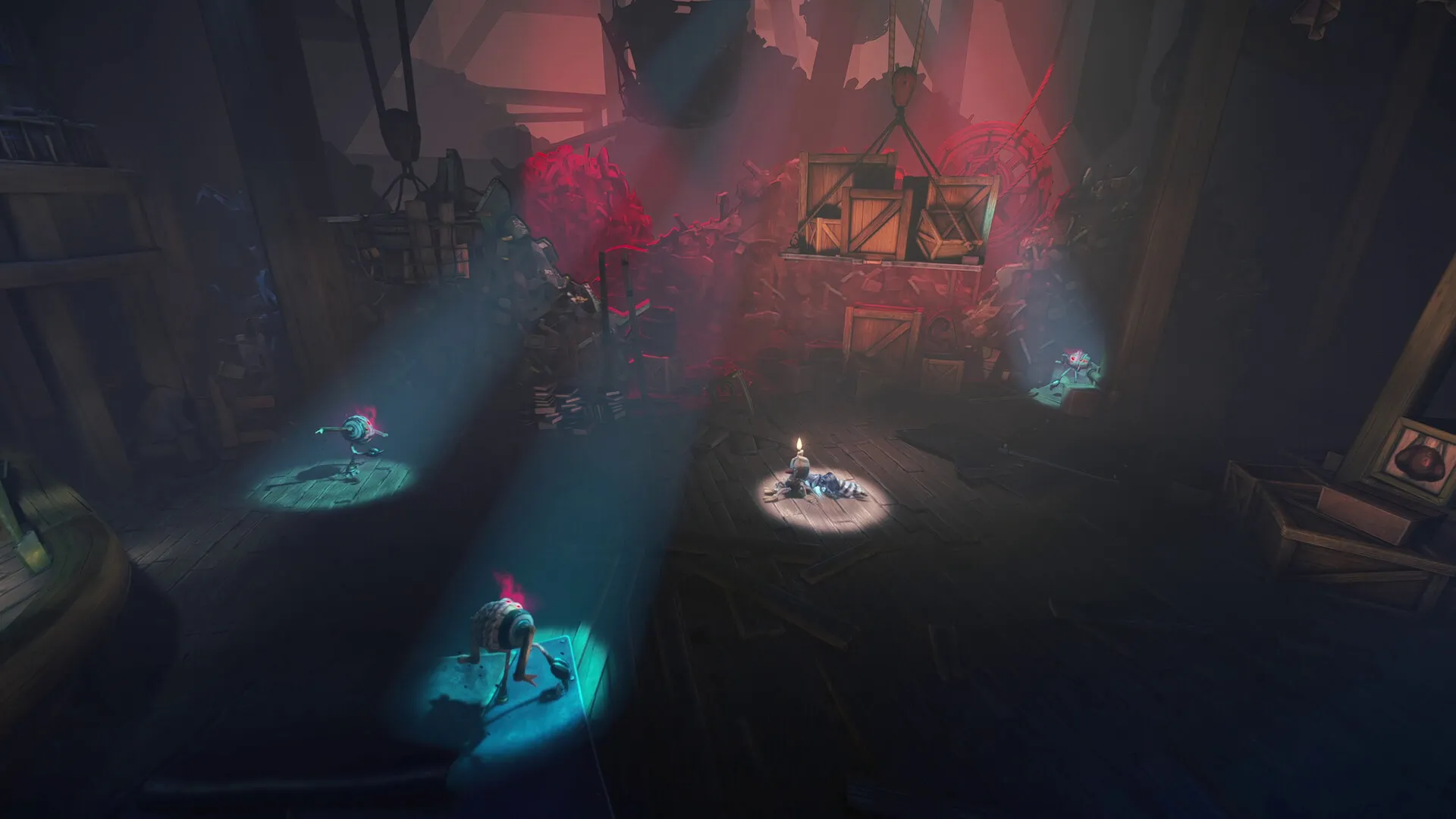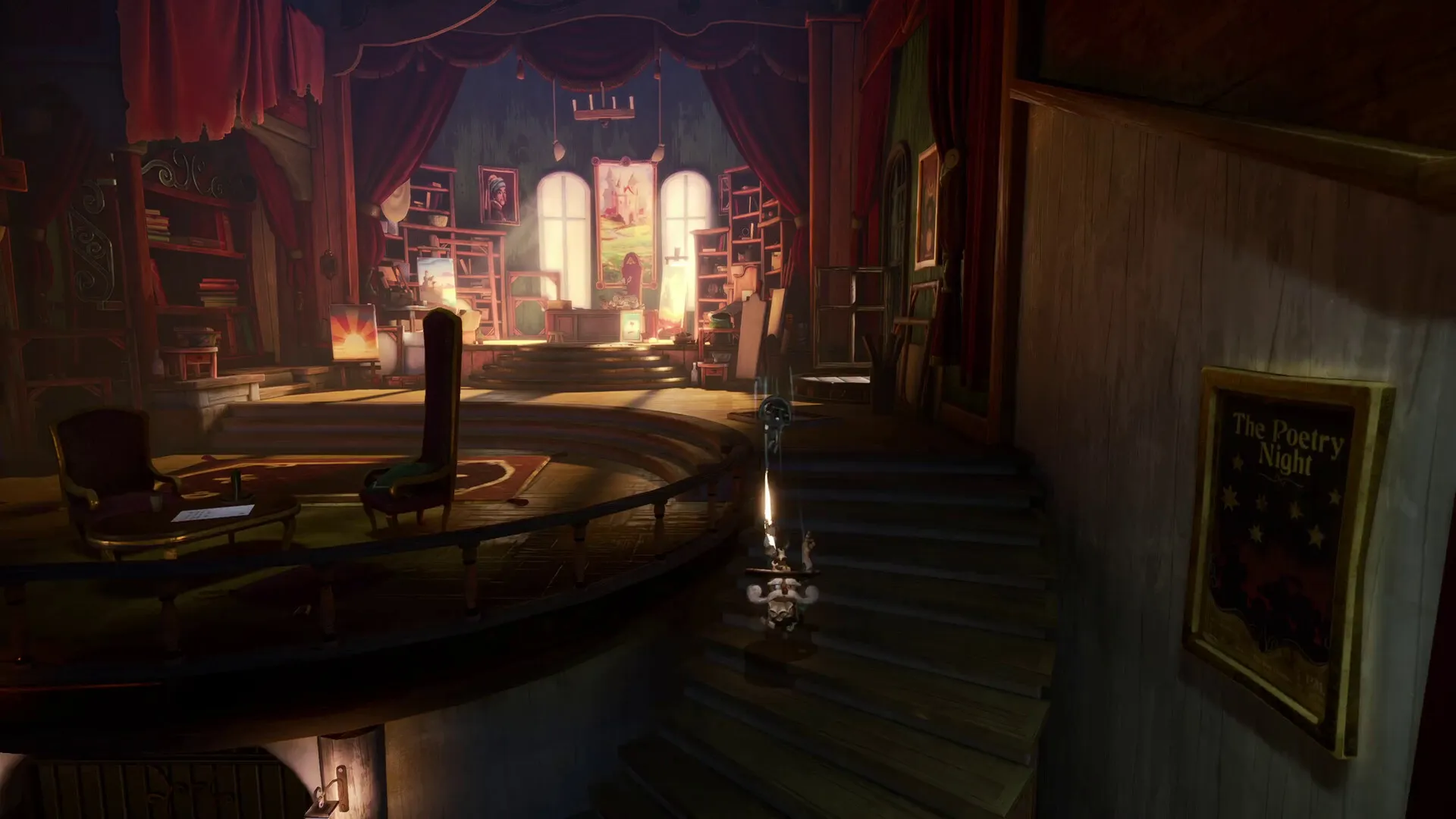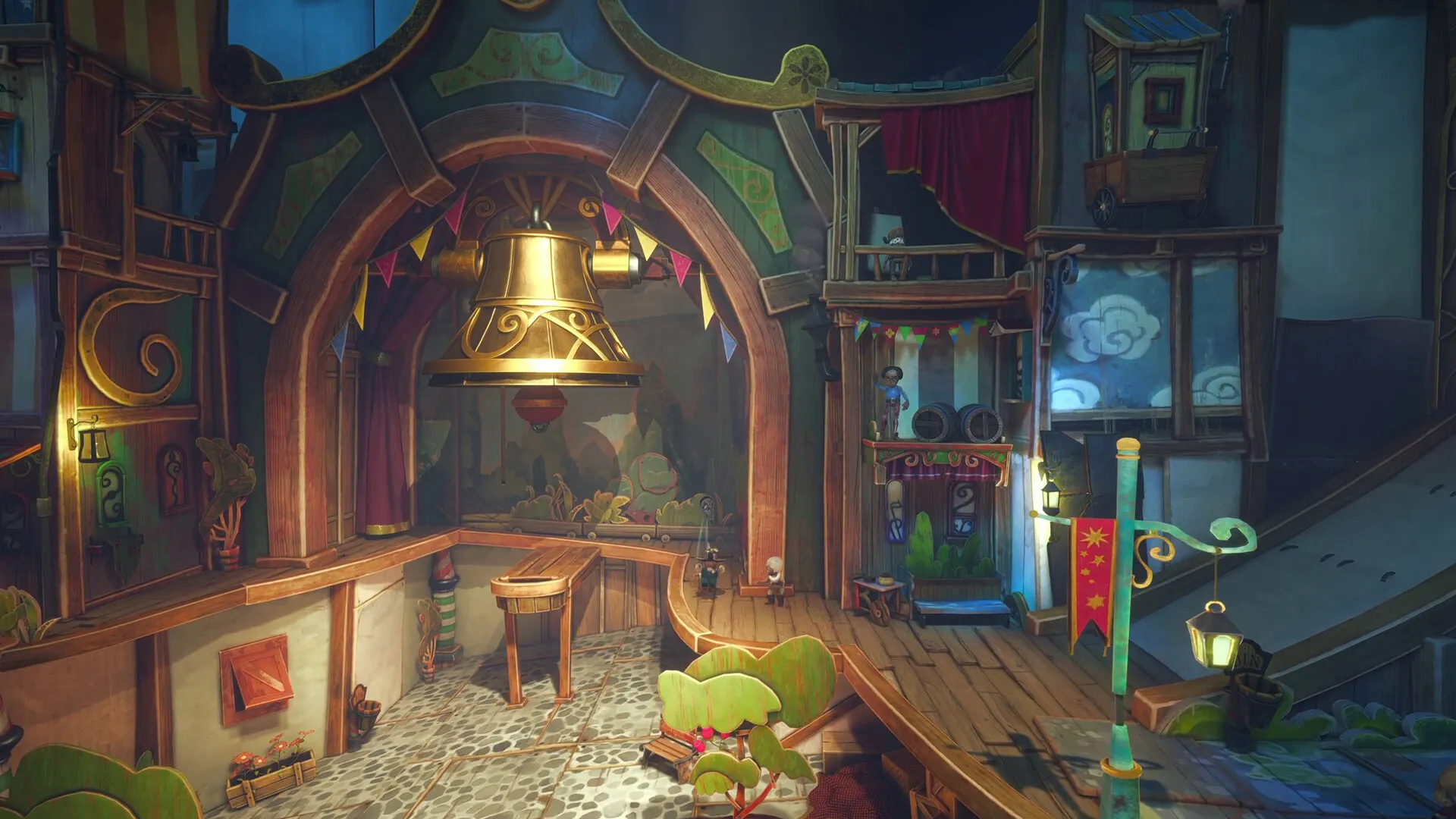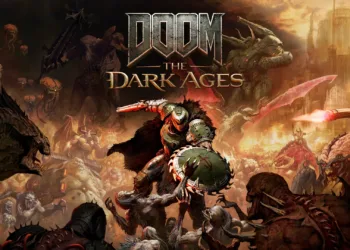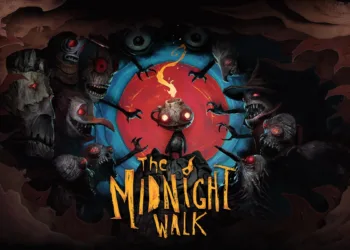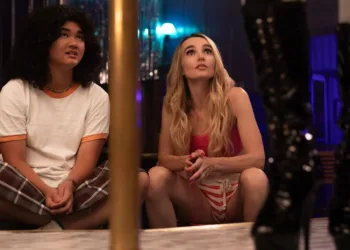In Once Upon a Puppet, every pull of a lever and leap across a collapsing stage feels woven into the narrative’s fabric. The dual-stick control—one side guiding Drev the puppet, the other steering Nieve the stagehand—creates a constant tension that echoes their magical bond. Rather than splitting focus, this split input reinforces the story’s core conflict: two characters forced to move in sync despite opposing desires.
Puzzle design often veers into platforming beats where narrative stakes rise in tandem with mechanical complexity. Early levels introduce basic grab-and-release sequences as a metaphor for the characters’ initial mistrust. When later chapters grant abilities like double jumps or grappling hooks, those tools aren’t tacked on; they correspond with moments of character growth—a newfound trust, a shared memory unlocked. This alignment of system and storytelling recalls how Brothers: A Tale of Two Sons used dual analog controls to emphasize sibling bonds, but Once Upon a Puppet sharpens that concept through its theatrical framing.
Choices here aren’t dialogue trees but exploration paths and collectible hunts. Opting to venture off the main path for stained-glass fragments yields extra lore vignettes that deepen emotional investment. Skipping them leaves gaps in context—inviting players to weigh curiosity against efficiency, much like indie narrative games such as Night in the Woods reward environmental reading over rushing forward. When you choose to rescue a discarded prop NPC or bypass a side puzzle, the world shifts subtly: scripted lines change, new stage curtains lift, hinting that player agency carries weight.
Combat and stealth encounters with Stage Fright creatures lean light, demanding avoidance or creative distraction rather than reflexive button-mashing. This choice underscores repression themes—running silent feels more poignant than striking back. For a game that sits at the intersection of puzzle-platformer and narrative-driven indie, these systems strike an effective balance: they demand technical skill while drawing out emotional beats, keeping both casual explorers and mechanics-minded players engaged without compromising either side.
Curtains Up on a Shattered Stage
Once Upon a Puppet splits its world between the pristine Front Stage—where perfection reigns—and the Understage of discarded dreams. This contrast isn’t window dressing. The Front Stage’s polished surfaces and strict aesthetic codes embody a society terrified of flaw, while the Understage’s ragtag scaffolding and abandoned props reflect the consequences of unattainable standards. Stage Fright creatures, born from fear itself, roam the shadows below, their presence a literal embodiment of repressed anxieties.
Nieve’s arc threads through these layers. Cast out after a failed performance, she begins as distant and guarded, her only goal to cut the Spiritbound Spool tethering her to Drev. Each acquired ability—be it a double jump or grappling hook—marks a moment of vulnerability and cooperation, mirroring her gradual shift toward empathy. Drev, meanwhile, grows from a curious puppet into a spirited foil, his youthful optimism exposing Nieve’s reluctance. Their evolving bond drives every scripted exchange and interactive beat.
The Spiritbound Spool itself operates as both a puzzle mechanic and a metaphor for interdependence. Early tasks focus on severing levers or ropes in isolation, only to evolve into multi-step challenges requiring synchronized pulls and leaps. This progression parallels the quest’s turning point: letting go of individual agendas to tackle a prophetic mission that holds the kingdom’s fate.
Supporting characters enrich the tapestry through well-placed dialogue and environmental lore. Talking to slum-dwelling NPCs reveals fragments of past lives, while stained-glass shards scattered across stages unlock silent flashbacks—subtle world-building that rewards exploration.
At its core, the game wrestles with identity and redemption. Who earns a spotlight, and who is doomed to the wings? Through clever narrative layering and thematic echo in its systems, Once Upon a Puppet asks players to confront the cost of perfection and discover value in what was once cast aside.
String Logic and Puppet Physics
Once Upon a Puppet’s core loop hinges on its dual-character control. Drev’s movements map to the left stick and L2, while Nieve responds to the right stick and R2. Early on, simple tasks—grabbing levers separately—feel intuitive. As puzzles demand simultaneous inputs, timing becomes vital: Drev might hold a platform steady while Nieve crosses a gap. This coordination turns what could be a gimmick into a rich tapestry of player engagement, reminiscent of how Brothers: A Tale of Two Sons united two characters through mirrored controls.
Traversal abilities arrive at steady intervals, each one echoing a narrative beat. A basic jump and grab evolve into a double jump, then a soft glide, and eventually a grappling bow that shoots ropes across distant fixtures. These tools unlock fresh puzzle variety: double jumps let Drev reach high crates, while the grappling bow lets Nieve pull distant switches. Pacing here strikes a smart balance—no single ability overstays its welcome, and by the time you master a tool, the next one reshapes familiar scenes into new challenges.
Environmental puzzles blend lever-pulling, weight-based switches and movable crates crafted from cardboard and wood. Physics feels grounded: tipping a box off its hinge triggers a cascade, or a string pulley creaks under pressure. The game’s materials-themed art direction isn’t cosmetic; it ties directly into puzzle solutions. Dropping a wooden plank might bridge a gap, while unspooling a paper backdrop reveals a hidden switch.
Platforming sequences embrace the 2.5D setup, with depth navigation adding a third dimension to timing. Moving platforms shift closer or further away, forcing split-second decisions on when to advance or retreat. Precision jumps onto narrow beams demand both spatial awareness and an eye for the camera’s angle—a common hurdle in indie titles that toy with 2.5D perspectives.
Stage Fright encounters strip away combat complexity: one touch means restart. Stealth and sound cues become your arsenal. Enemies patrol on squeaking wooden feet; staying silent often feels safer than direct confrontation, reinforcing the theme of performance anxiety.
Collectibles pepper stages in the form of theatrical props—each carrying a famous quote—and stained-glass fragments. Hunting these optional items rewards players with deeper lore scenes and small mechanical tweaks, encouraging exploration for those who relish narrative context and completion.
Blueprints of the Backstage: Level Design Unveiled
Once Upon a Puppet unfolds across roughly eight chapters, each anchored by a distinct theatrical theme. Early acts introduce the basics—rusted slums stitched from cardboard, quiet town squares carved from plywood—before shifting into midgame stages where broken catacombs and drifting stage curtains frame more complex puzzles. Chapters vary in length: opener segments run tight, around 15–20 minutes, while middle chapters can stretch beyond half an hour, occasionally leading to pacing dips.
Mechanic rollout follows a steady rhythm. The double jump debuts in Chapter Two, glide comes in Chapter Three, and the grappling bow arrives by Chapter Five. This clear onboarding mirrors games like Ori and the Blind Forest, yet the final chapters reuse existing tools heavily, creating a sense of repetition that some players may find too familiar.
Exploration balances linear corridors with moments of open hub areas. Town stages let you speak with NPCs for extra lore—echoing the conversational pockets in Celeste’s hamlet—while later levels lock you into narrow beams of progression. Hidden alcoves and secret side rooms reward curiosity, though some feel more cosmetic than vital.
Visual variety keeps the eye engaged: golden Front Stage catwalks, grimy Understage trenches and puppet-controlled backdrops lend each environment its own logic puzzle. Yet mechanical differentiation between areas sometimes falls short, as similar lever-and-platform setups recur.
Autosaves trigger at scene changes, and respawn points sit just before major obstacles. This frequent checkpointing prevents lengthy replays, though dying during timed sequences can still pull the tension from high-stakes platforming, reminding players that even a brief misstep may cost momentum.
A Stage of Cardboard Dreams and Wooden Echoes
Once Upon a Puppet’s visual identity leans into its theatrical motif. Cardboard backdrops and wooden character models create a handcrafted feel, as if each level were assembled by a meticulous stage crew. Lighting contrasts—warm spotlights against shadowy rafters—lend depth to the layered “pop-up book” staging, guiding your eye along platforms and through hidden alcoves. Textures vary from smooth plywood floors to rough rope pulleys, reinforcing the tactile quality of every interactive element.
Character animations embrace puppet-like weight. Drev’s limbs swing with a satisfying inertia, while Nieve’s disembodied hand gestures convey intent through subtle motions. Stage Fright enemies appear as torn scraps of fabric and warped wood, their jerky movements and hollow calls reinforcing the idea of repressed fears given form. These designs stay on theme without overwhelming gameplay clarity.
Arkadiusz Reikowski’s score underpins the action with whimsical flourishes—light piano trills when solving puzzles, deeper cello strains as memories unfold. Dynamic shifts accentuate narrative turns, but the music never intrudes. Diegetic sounds—rattling wooden joints, creaking stage machinery, distant echoes—heighten immersion and serve as audio cues during stealth sections, much like environmental storytelling in Hollow Knight.
Story beats unfold through stained-glass vignettes that frame silent tableaux, then resume with crisp text dialogue. The absence of full voice acting keeps focus on interactivity, yet brief voiced exclamations punctuate tense moments, ensuring key lines land with emotional weight.
When the Strings Snag: Performance Under the Spotlight
Throughout my playthrough, frame stability wavered on PlayStation 5—dips into the low 30s occurred during its most elaborate scenes, dragging momentum from precision platforming moments. These slowdowns felt most pronounced when multiple physics-driven objects populated the screen, making a well-timed zip-line hook or split-second double jump more nerve-wracking than intended.
Visual hiccups surfaced alongside. On occasion, Nieve would clip through wooden floors or vanish momentarily above Drev’s head, forcing restarts in tighter puzzle rooms. Stage Fright sludge sometimes slid through scenery, undercutting tension by obscuring intended pathways. Hit-detection proved uneven: jumping through a target zone one moment, only to miss it the next, echoed frustrations found in other physics-heavy indies like Unravel.
Despite these snags, controls remain sharply tuned when performance holds. Jumps launch without perceptible delay, and the grappling bow clicks into place with satisfying accuracy—each mapping decision feels intuitive out of the box, sparing players from menu tinkering.
Minor yet thoughtful options pepper the interface: adjustable subtitle sizes, clear button prompts, and a choice of two difficulty presets for puzzles. Load times hover under 10 seconds between stages, keeping transitions fluid. These small comforts help steady the experience when technical quirks threaten to pull attention away from the tale woven on its wooden stage.
Encore Acts and Hidden Curtains
Once Upon a Puppet sprinkles optional collectibles throughout its stages, rewarding thorough explorers. Gathering all stained-glass shards unlocks silent lore vignettes that reveal character backstories, layering emotional depth for those who pursue every fragment. Costume unlocks serve a dual purpose: some yield small gameplay tweaks—like a slight speed boost—while others represent narrative milestones, dressing Drev in outfits tied to his theatrical past and giving players another reason to revisit earlier levels.
Speed-run enthusiasts will find the game’s tight level layouts and consistent checkpoint placement friendly to timed attempts. Each ability chain—double jump into grapple, glide across gaps—feels engineered for chaining moves fluidly, much like the movement quirks in Celeste’s B-Side challenges. However, no official challenge mode or leaderboard support exists, so high-score chases rely on community-organized events rather than in-game systems.
Post-game content is limited: once the credits roll, no new chapters emerge, and extra costumes simply live in a menu. Still, Flatter Than Earth has shown quick turnaround on bug fixes and balance updates, smoothing frame-rate hiccups and refining grab responsiveness since launch. Early player forums hint at modders eyeing custom skins or puzzle tweaks, suggesting a budding community passion for expanding the puppet stage beyond its original script.
Final Curtain Call
Once Upon a Puppet shines in its handcrafted environments and the way every mechanic echoes narrative themes. The dual-character control deepens the bond between Nieve and Drev, while physics-driven puzzles, layered backdrops and expressive animations create an unmistakable theatrical charm.
That strength can also be a source of friction. Mechanic variety peaks early, and repeated use of familiar tools can leave later chapters feeling stretched. Technical hiccups—frame dips and occasional clipping—undercut key moments of precision platforming. Pacing ebbs when exploration stalls or puzzles lean on routine patterns.
For players drawn to indie titles rich in visual storytelling and light puzzle challenges, this production offers an engaging stage. Those who appreciate seamless mechanical depth—where each new ability redefines playspaces—may find the mid- and late-game choreography a touch predictable.
Whether the game’s handcrafted magic holds sway depends on how much weight you give its atmosphere versus mechanical innovation. If theatrical world-building and character-driven puzzles resonate, this performance will captivate. But if you crave a crescendo of fresh challenges in every act, you might catch yourself waiting for the next surprise beyond the final curtain.
The Review
Once Upon A Puppet
Once Upon a Puppet delivers a handcrafted theatrical world where dual-character controls and physics-based puzzles echo its story of interdependence. Its visual charm and narrative cohesion keep players engaged, even as midgame mechanics grow repetitive and occasional frame drops interrupt flow. Enthusiasts of narrative-driven platformers will find much to admire, though those seeking relentless variety may feel the final act lingers.
PROS
- Handcrafted art direction brings each level to life with tactile detail
- Dual-character controls reinforce the story’s themes of cooperation
- Physics-driven puzzles integrate seamlessly with narrative progression
- Expressive animations and dynamic lighting enrich atmosphere
- Whimsical score and diegetic sounds heighten emotional beats
CONS
- Midgame mechanic variety plateaus, making later puzzles feel familiar
- Frame-rate drops and clipping issues disrupt precision platforming
- Pacing slows in longer chapters with repetitive challenges
- Limited post-game content and no official challenge modes
- Occasional hit-detection quirks in tighter platforming segments








































